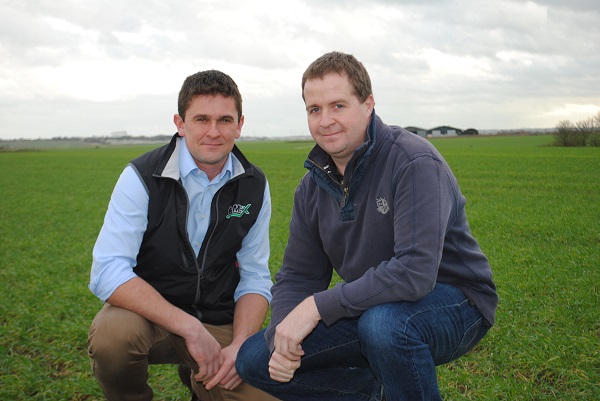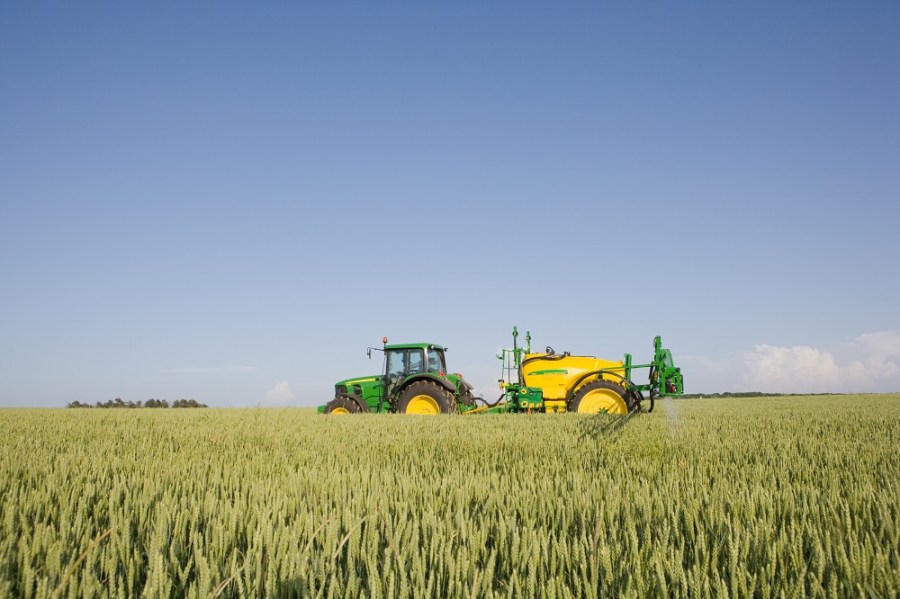While a move to liquid fertiliser has been a wise step for one Essex grower, it’s the difference in grain protein that has come into focus on the farm. CPM reports.
This extra protein was of the right quality for bread making.
By Rob Jones
Replacing the granular fertiliser regime for one based entirely on liquid is having a positive impact on gross margins for Essex cereal farmer, James Faulkner, partner in farming enterprise R Davidson and Son.
Based near Peldon, notable for its difficult to control blackgrass, the farm is about 1500ha on mostly London clay or Hanslope soils. An average year’s cropping is 800ha of Group 1 milling wheat (Skyfall, Crusoe), 200ha of oilseed rape, 100ha grass ley and 400ha of spring crops of peas, sugar beet and maize. Target wheat yields are around 11-12t/ha and up to 14% protein. Most of the crops are sold on forward contracts, with minimum premiums, to a number of merchants.
Wheat fields are either ploughed or cultivated with a Väderstad TopDown and Rexius Twin straight behind the combine creating a false seedbed. Grassweeds are sprayed off before drilling with an 8m Väderstad Rapid pulled by a Quadtrac, then rolled before pre-emergence sprays are applied for blackgrass control.
Pushing up yields
“This year we’ll have been growing continuous wheat for 60 years on 115ha with many other fields on 30 years. The new generation of varieties are pushing up yields but at the expense of protein, so it’s becoming increasingly necessary to apply late foliar nitrogen to achieve our protein targets for milling wheats,” he explains.

James Faulkner (right) and Omex adviser Mark Riches believe it’s becoming increasingly necessary to apply late foliar nitrogen to achieve protein targets on milling wheats.
“Being on the drier East coast, with an average annual rainfall of 520mm, we also get cooler summers giving an early start to harvest, which helps us retain Hagbergs and specific weights.
“We’ve always used 18% foliar nitrogen at the milky ripe stage (GS 75) while the spring nitrogen application has traditionally been a granular urea. This year is the first full season where we’re going to be using all liquids,” he explains.
“The decision was predominantly due to running on wider tramlines – 40m boom width – together with the improved accuracy, an increase in work rates and the number of suitable application days for applying liquid fertiliser.”
The change has meant there’s no need for all the machinery associated with solid fertiliser applications, less requirement for storage space and the farm has been able to reduce the manpower involved by one, creating cost savings.
James Faulkner reckons that granular fertiliser application tailed off on the headlands which affected protein consistency and specification across the whole field. “It’s very dry here so liquid fertiliser suits the farm much better. We could have continued to use granular but it’s not as accurate and nutrient uptake is compromised where moisture is lacking.”
Another issue with granular fertiliser that prompted the change, is that urea risks a higher rate of volatilisation compared with liquid nitrogen, which is more readily available to the plant. As a result, liquid application is a more cost-effective method of applying nitrogen, he believes.
To some extent, the clincher in the move to liquid fertiliser are some on-going Omex replicated trials that were carried out last year on the farm. Using the variety Gallant, the aim has been to validate the efficacy of late foliar applied nitrogen, aimed at increasing protein levels in milling wheat.
Four replications
There were four replications per treatment across a total of 10 treatments and one untreated. The treatments included Protein Plus (40kgN/ha) with and without sulphur, applied at rates of 150 and 200 l/ha, alongside two different brands of low volume ammonium thiosulfate (11kgN/ha). The plots were drilled on Sept 26 2014 into London Clay soils, with the crop receiving a standard pesticide programme.
The trials were specifically aimed at testing different application rates of urea-based foliars against the standard 200

David Booty wanted to see if there was a direct relationship between the amount of N applied and the final protein level achieved.
l/ha of Protein Plus, which supplies 40kgN/ha, explains David Booty of Omex. “We wanted to see if there was a direct relationship between the amount of N applied and the final protein level achieved,” he says.
“We also wanted to try some different additives with Protein Plus to see if these improved the final result and to test the quality of the grain produced for bread making. A key objective was to counter the persistent criticism that late-applied foliar N creates a false protein reading from N deposited on the outside of the seed, without improving the usable protein levels within the grain itself.”
David Booty adds that results from the trial and from subsequent independent quality testing at Campden BRI, showed that there was a trend for all of the treatments to give a yield increase, which doesn’t happen in every instance and was probably due to the particular climatic pattern in 2015.
“The best results were from treatments based on Protein Plus or Protein Plus S at 200 l/ha, which gave 16-19% additional yield (see table on pxx). All the applications improved grain protein, but the higher rate applications were clearly more effective, in line with the AHDB recommendation to apply 40kgN/ha late for protein,” he points out.
“Protein Plus S at 200 l/ha, raised grain protein by 2.6%. Sulphur is also a major component of grain protein, and sulphur availability along with the nitrogen in the right proportions contributed to this result. Significantly, the samples from this trial all produced high quality bread, suggesting the final protein analysis was accurate and not a false reading due to liquid N application.
“This result is very much in line with the published research review from AHDB in 2001, which concluded that late foliar N could improve yield, but this was variable, and could certainly raise protein levels. In addition, this extra protein was of the right quality for bread making.”
James Faulkner was impressed that the Protein Plus returned the highest yield at 2t/ha over the untreated crop that yielded 10.5t/ha.
“In reality, we wouldn’t expect extra foliar nitrogen applied at milky ripe to give us the extra yield, but we’re convinced that the increased protein did come from this N timing, which increased further where liquid N was applied at higher volumes.
“Although the benefit of low volume applications is that more land can be covered in a tank and they can be mixed with agrochemicals, the benefit of higher volume applications – as the trial results prove – is they work.”
He adds that while higher volume means less area covered in a day, he can compensate for this by applying liquid N at night, when there’s no risk of scorch from the sun.
“It also means we can pick the optimum timing for the high volume products such as Protein Plus. We wanted the low volume approach to work because it would take less time and reduce work load pressure, but it doesn’t deliver reliably.”
Further trials will be carried out on the farm this summer to look at earlier application and split doses.
Late N treatment results
| Treatment | Yield t/ha adjusted to 14% moisture | Protein % |
| Untreated | 10.54 | 12.00 |
| ATS 33 l/ha | 11.77 | 12.59 |
| Protein Plus S 150 l/ha | 12.21 | 13.50 |
| Protein Plus 200 l/ha | 12.41 | 13.98 |
| Protein Plus S 200 l/ha | 11.70 | 14.60 |
Source: Omex




